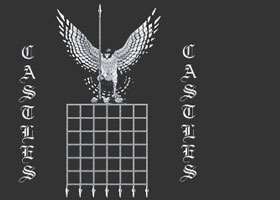| Iron And Bronze Age Architecture |
| | Iron and Bronze Age Architecture
The Bronze Age is dated between 1800 - 600 BC the Iron Age is dated between 600 BC - 400 AD. Iron and Bronze Age Architecture emerged as the social and cultural environment moved on from small Neolithic groups of people of the Stone Age to much larger tribes. Bronze and Iron Age Hillforts mark the transition to an organised community of people with leaders or Kings. Tribal disputes and warfare escalated as did the use of more sophisticated and lethal weapons made first of Bronze and then of Iron. | | | |
Iron And Bronze Age Architecture - Facts and Information about Iron And Bronze Age Architecture. Social & cultural change?
- Changing needs of the population
- Skills available? Materials? Workforce?
- The Design, Layout of Iron And Bronze Age Architecture
The History of Iron and Bronze Age Architecture
The History of Iron and Bronze Age Architecture encompasses the Bronze and Iron Age Hillforts - the ancient forts, or fortresses, which sat on the top of hills! Iron and Bronze Age Architecture moved away from building the massive sacred Stone Monoliths such as Stonehenge and the idea of the Causewayed Camps were developed still further with the advent of the Hillforts. The Hillforts were developed due to more sophisticated weapons made first bronze and then of lead. The pattern of fortress and castle development and changing architecture continued up to the English Medieval Castles. The evidence of more than 2000 Hillforts have been found in Britain! Hillforts - the Bronze and Iron Age equivalent to a medieval castle! Iron and Bronze Age Architecture and Constructions
Bronze and Iron Age Architecture in England was focussed around the construction of Hillforts. The architecture of Iron and Bronze Age Hillforts centred around a series of detached buildings (homesteads, or farmhouses, granaries and communal gathering areas). They were surrounded by at least one concentric bank and ditch. The Bonze and Iron age architecture featured gateways, barbicans, guardhouses, towers, ramparts, palisades, and parapets. These are all terms of architecture that we commonly associate with Medieval castles! These were massive constructions of the Iron and Bronze Age. The biggest Hillfort in England was called Maiden Castle. Its original ditch and bank measured a massive 545 metres, with ramparts reaching a height of 20 feet - 6 metres! |
Iron and Bronze Age Architecture - Time
Time is an important factor in Iron and Bronze Age architecture: - Social and cultural change?
- Iron and Bronze Age Architecture, especially in respect of the Hillforts, reflected the social changes of people - living in large settlements permanently occupied by tribes of people
- Cultural changes led to tribes being ruled by Kings and Leaders
- The Iron and Bronze Age Hillforts provided a meeting place for increased trading
- Changing needs of the population?
- The Iron and Bronze Age saw rising population levels
- The Hillforts provided shelter from the climate for people and animals. They provided a safe retreat against intrusion or invasion from other tribes
- What materials were readily available for Iron and Bronze Age Architecture?
- Hillforts were constructed using stone, soil and wood - Timber was favoured as it was clearly lighter to transport up the hilltops and was used for strengthening the ramparts and for interior building construction
- Were the materials easily accessible?
- Yes! Materials were usually obtained from the original site
- How would the materials be transported?
- The wheel had been invented! Carts and wagons were available
- What technology, in terms of the building tools, were available?
- The Bronze Age was characterized by the first use of metal tools in human civilization. First copper, then bronze. The process of smelting was discovered in which metal was extracted from an ore through the use of heat. A mixture of tin and copper ore, heated together, made bronze. Bronze tools were harder and more durable.
- It was then discovered how to extract Iron from ore
- Cheap and durable metal tools such as the hook and axe-heads were produced
- New building techniques, construction methods and ideas
- See the sections on Hillforts and Maiden Castle for full details of these types of Bronze and Iron Age architecture
- The Skills available? The Workforce?
- Many skills were required - building, metal production, stone cutting, transportation, organising resources etc. To build the hillforts would have taken a labour force of hundreds, and in the instance of Maiden Castle thousands - mostly slaves!
The answers to these basic questions relating to Iron and Bronze Age architecture provide a historical doorway into past cultures and eras. Iron and Bronze Age Architecture - Location
The location is an extremely crucial aspect of Iron and Bronze Age architecture. Deciding where a Hillfort should be situated was a major consideration: - Hillforts - Defensive and offensive advantages
- On top of a hill - site of Hillforts
Iron and Bronze Age Architecture - Design
The design of Iron and Bronze Age architecture had to be a combination of practical use and the aesthetic design! Iron and Bronze Age architecture had to take the following into consideration: - What did the design and architecture of the Causewayed Camps want to convey? Fear, Awe, Domination, Envy, Submission, Respect, Power, Wealth - exactly the same requirements as for castles!
- Economy - The Iron and Bronze Age Hillforts would have required considerable expense in terms of man power and deployment of labour - the use of slaves was considerable
Architecture in England
The different styles of architecture in Britain provide a historical doorway into past cultures and eras and provide an insight into the development of the Medieval Castles of England and Wales. |
|
|

